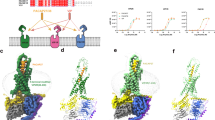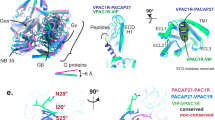Abstract
Vasoactive intestinal peptide (VIP) is implicated in many physiological and pathophysiological processes, and its receptors are promising targets for the development of new drugs. The human VPAC1 receptor for VIP and pituitary adenylate cyclase-activating polypeptide is a class II G protein coupled receptor. The N-terminal ectodomain (N-ted) of the VPAC1 receptor is a major VIP binding site. To determinate the high resolution structure of the VPAC1 receptor N-ted, large quantities of purified recombinant N-ted produced are required. The N-ted sequence (31–144), which is fused to thioredoxin protein and 6×His tag, was expressed into Origami Escherichia coli strain. Purification of recombinant N-ted using Ni-NTA affinity column associated to Nu-polyacrylamide gel electrophoresis analysis reveals the presence of one single band of Mw 19,000 corresponding to the purified recombinant N-ted. The purified N-ted was able to recognize VIP and the selective antagonist PG96–269. About 5–10 mg of functional purified protein/liter of bacterial culture is currently produced. This is a crucial step to determine the structure of functional human VPAC1 receptor N-ted by nuclear magnetic resonance.



Similar content being viewed by others
References
Bechet, J.-J., Houadjeto, M., & d’Albis, A. (1986). Active-site titration of enzymes at high concentration. European Journal of Biochemistry, 161, 343–349.
Ceraudo, E., Murail, S., Tan, Y. V., Lacapere, J. J., Neumann, J. M., Couvineau, A., et al. (2008). The vasoactive intestinal peptide (VIP) a-helix up to C terminus interacts with the N-terminal ectodomain of the human VIP/pituitary adenylate cyclase-activating peptide 1 receptor: Photoaffinity, molecular modeling, and dynamics. Molecular Endocrinology, 22, 147–155.
Christopoulos, A., Christopoulos, G., Morfis, M., Udawela, M., Laburthe, M., Couvineau, A., et al. (2003). Novel receptor partners and function of receptor activity-modifying proteins. Journal of Biological Chemistry, 278, 3293–3297.
Couvineau, A., Lacapère, J. J., Tan, Y. V., Rouyer-Fessard, C., Nicole, P., & Laburthe, M. (2003). Identification of cytoplasmic domains of hVPAC1 receptor required for activation of adenylyl cyclase. Journal of Biological Chemistry, 278, 24759–24766.
Couvineau, A., Rouyer-Fessard, C., & Laburthe, M. (2004). Presence of a N-terminal signal peptide in class II G protein-coupled receptors: crucial role for expression of the human VPAC1 receptor. Regulatory Peptides, 123, 181–185.
Ganea, D., & Delgado, M. (2002). Vasoactive intestinal peptide (VIP) and pituitary adenylate cyclase-activating polypeptide (PACAP) as modulators of both innate and adaptive immunity. Critical Reviews in Oral Biology and Medicine, 13, 229–237.
Gomariz, R. P., Juarranz, Y., Abad, C., Arranz, A., Leceta, J., & Martinez, C. (2006). VIP-PACAP system in immunity. Annals of the New York Academy of Sciences, 1070, 51–74.
Gourlet, P., De Neef, P., Cnudde, J., Waelbroek, M., & Robberecht, P. (1997). In vitro properties of a high affinity selective antagonist of the VIP1 receptor. Peptides, 18, 1555–1560.
Gozes, I., Fridkinb, M., Hill, J. M., & Brenneman, D. E. (1999). Pharmaceutical VIP: prospects and problems. Current Medicinal Chemistry, 6, 1019–1034.
Grace, C. R., Perrin, M. H., DiGruccio, M. R., Miller, C. L., Rivier, J. E., Vale, W. W., et al. (2004). NMR structure and peptide hormone binding site of the first extracellular domain of a type B1 G protein-coupled receptor. Proceedings of the National Academy of Sciences of the United States of America, 101, 12836–12841.
Laburthe, M., Couvineau, A., & Marie, J. C. (2002). VPAC receptors for VIP and PACAP. Receptors Channels, 8, 137–153.
Laburthe, M., Couvineau, A., & Tan, V. (2007). Class II G protein-coupled receptors for VIP and PACAP: structure, models of activation and pharmacology. Peptides, 28, 1631–1639.
Parthier, C., Kleinschmidt, M., Neumann, P., Rudolph, R., Manhart, S., Schlenzig, D., et al. (2007). Crystal structure of the incretin-bound extracellular domain of a G protein-coupled receptor. Proceedings of the National Academy of Sciences of the United States of America, 104, 13942–13947.
Rabhi-Essafi, I., Sadok, A., Khalaf, N., & Fathallah, D. M. (2007). A strategy for high-level expression of soluble and functional human interferon alpha as a GST-fusion protein in E. coli. Protein Engineering Design and Selection, 20, 201–209.
Said, S. I., & Mutt, V. (1970). Polypeptide with broad biological activity: isolation from small intestine. Science, 169, 1217–1218.
Sun, C., Song, D., Davis-Taber, R. A., Barrett, L. W., Scott, V. E., Richardson, P. L., et al. (2007). Solution structure and mutational analysis of pituitary adenylate cyclase-activating polypeptide binding to the extracellular domain of PAC1-RS. Proceedings of the National Academy of Sciences of the United States of America, 104, 7875–7880.
Tan, Y. V., Couvineau, A., Van Rampelbergh, J., & Laburthe, M. (2003). Photoaffinity labeling demonstrates physical contact between vasoactive intestinal peptide and the N-terminal ectodomain of the human VPAC1 receptor. Journal of Biological Chemistry, 278, 36531–36536.
Tan, Y. V., Couvineau, A., & Laburthe, M. (2004). Diffuse pharmacophoric domains of vasoactive intestinal peptide (VIP) and further insights into the interaction of VIP with the N-terminal ectodomain of human VPAC1 receptor by photoaffinity labeling with [Bpa6]-VIP. Journal of Biological Chemistry, 279, 38889–38894.
Tan, Y. V., Couvineau, A., Murail, S., Ceraudo, E., Neumann, J. M., Lacapère, J. J., et al. (2006). Peptide agonist docking in the N-terminal ectodomain of a class II G protein-coupled receptor, the VPAC1 receptor. Photoaffinity, NMR, and molecular modeling. Journal of Biological Chemistry, 281, 12792–12798.
Acknowledgements
This research was supported by the Institut National de la Santé et de la Recherche Médicale, the Université Paris-Diderot (Paris 7), the Centre National de la Recherche Scientifique, and also by grant in 2007 from Association de Recherche sur la Polyarthrite.
Author information
Authors and Affiliations
Corresponding author
Rights and permissions
About this article
Cite this article
Couvineau, A., Robert, JC., Ramdani, T. et al. Production and Purification of Large Quantities of the Functional N-Terminal Ectodomain of Human VPAC1 Receptor. J Mol Neurosci 36, 249–253 (2008). https://doi.org/10.1007/s12031-008-9072-8
Received:
Accepted:
Published:
Issue Date:
DOI: https://doi.org/10.1007/s12031-008-9072-8




